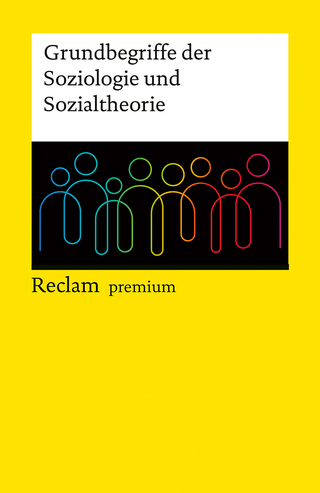
Approaches to Social Research
Oxford University Press Inc (Verlag)
978-0-19-061424-9 (ISBN)
this book provides a lucid treatment of the four major approaches to research: experimentation, survey research, field research, and the use of available data. Richly developed examples of empirical research
and an emphasis on the research process enable students to better understand the real-world application of research methods. The authors also offer a unique chapter (13) advocating a multiple-methods strategy.
Royce A. Singleton, Jr., is Professor of Sociology at the College of the Holy Cross. Bruce C. Straits is Professor Emeritus of Sociology at the University of California, Santa Barbara.
Preface
Chapter 1. Introduction
Why Study Research Methods?
Consuming Research Evidence
Producing Research Evidence
Methodological Approaches to the Social World
Some Preliminary Research Questions
An Experimental Answer
An Answer from Survey Research
An Answer from Field Research
An Answer from Available Data
Conclusions
An Overview of the Book
PART I: THE SCIENTIFIC AND ETHICAL CONTEXTS OF SOCIAL RESEARCH
Chapter 2. The Nature of Science
The Aim of Science
Science as Product
Scientific versus Nonscientific Questions
Knowledge as Description
Knowledge as Explanation and Prediction
Knowledge as Understanding
Tentative Knowledge
Science as Process
Durkheim's Study of Suicide
Logical Reasoning
Empiricism
Objectivity
Control
Critiques of Scientific Inquiry
The Ideal and the Reality of Scientific Inquiry
Alternative Models of Social "Science"
Summary
Chapter 3. Research Ethics
Data Collection and Analysis
Treatment of Human Subjects
Harm
Informed Consent
Deception
Privacy
Making Ethical Decisions
Values in Social Research: Science and Society
The Issue of Value Neutrality
Managing Personal Values
The Application of Research Findings
Summary
PART II: RESEARCH DESIGN
Chapter 4. Elements of Research Design
Origins of Research Topics
Units of Analysis
Aggregate Data
Ecological Fallacy
Variables
Types of Variables
Relationships
Relationships among Qualitative Variables
Relationships among Quantitative Variables
Relationships between a Qualitative and a Quantitative Variable
Statistically Significant Relationships
The Nature of Causal Relationships
Formulating Questions and Hypotheses
Research Purposes and Research Design
Stages of Social Research
Stage 1: Formulation of the Research Question
Stage 2: Preparation of the Research Design
Stage 3: Measurement
Stage 4: Sampling
Stage 5: Data Collection
Stage 6: Data Processing
Stage 7: Data Analysis and Interpretation
Summary
Chapter 5. Measurement
The Measurement Process
Conceptualization
Operationalization
Operational Definitions in Social Research
Verbal Reports
Observation
Archival Records
Selection of Operational Definitions
Levels of Measurement
Nominal Measurement
Ordinal Measurement
Interval Measurement
Ratio Measurement
Discussion
Reliability and Validity
Sources of Error
Reliability Assessment
Test-Retest Reliability
Split-Half and Internal Consistency Reliability
Intercoder Reliability
Improving Reliability
Validity Assessment
Subjective Validation
Criterion-Related Validation
Construct Validation
A Final Note on Reliability and Validity
Summary
Chapter 6. Sampling
Why Sample?
Population Definition
Sampling Designs
Probability Sampling
Random Selection
Simple Random Sampling
Stratified Random Sampling
Cluster Sampling
Systematic Sampling
Nonprobability Sampling
Convenience Sampling
Purposive Sampling
Quota Sampling
Other Sampling Designs
Combined Probability and Nonprobability Sampling
Referral Sampling
Factors Affecting Choice of Sampling Design
Stage of Research and Data Use
Available Resources
Method of Data Collection
Factors Determining Sample Size
Population Heterogeneity
Desired Precision
Sampling Design
Available Resources
Number of Breakdowns Planned
Final Notes on Sampling Errors and Generalizability
Summary
PART III: METHODS OF DATA COLLECTION
Chapter 7. Experimentation
The Logic of Experimentation
Testing Causal Relations
Matching and Random Assignment
Internal and External Validity
Sampling in Experiments
Staging Experiments
An Example: Who Will Intervene?
Subject Recruitment and Acquisition of Informed Consent
Introduction to the Experiment
The Experimental Manipulation
Manipulation Checks
Measurement of the Dependent Variable
Debriefing
Pretesting
Experimental and Mundane Realism
The Experiment as a Social Occasion
Demand Characteristics
Evaluation Apprehension
Other Motives of Experimental Subjects
Experimenter Effects
Minimizing Bias Due to the Social Nature of Experimentation
Experimentation Outside the Laboratory
Field Experiments
Experimental Designs in Survey Research
Units of Analysis Other than Individuals
Summary
Chapter 8. Experimental Designs
Threats to Internal Validity
Pre-experimental Designs
Design 1: The One-Shot Case Study
Design 2: The One-Group Pretest-Posttest Design
Design 3: The Static Group Comparison
True Experimental Designs
Design 4: The Pretest-Posttest Control Group Design
Design 5: The Posttest-Only Control Group Design
Design 6: The Solomon Four-Group Design
Within-Subjects Designs
Overview of True Experimental Designs
Factorial Experimental Designs
Interaction Effects
Quasi-experimental Designs
Example 1: Interracial Attitudes and Behavior at a Summer Camp
Example 2: The Connecticut Crackdown on Speeding
Summary
Chapter 9. Survey Research
General Features of Survey Research
Large-Scale Probability Sampling
Systematic Procedures: Interviews and Questionnaires
Quantitative Data Analysis
Secondary Analysis of Surveys
Survey Research Designs
Cross-Sectional Designs
Longitudinal Designs
Steps in Survey Research: Planning
Face-to-Face and Telephone Interviewing
Face-to-Face Interviewing
Telephone Interviewing
Paper-and-Pencil Questionnaires
Computer-Assisted Self-Interviews
Mixed-Mode Surveys
Field Administration
Interviewer Selection
Interviewer Training
Pretesting
Gaining Access
Interviewing
Supervision and Quality Control
Follow-Up Efforts
Strengths and Limitations of Surveys
Summary
Chapter 10. Survey Instrumentation
The Survey as a Social Occasion
Materials Available to the Survey Designer
Open-Ended and Closed-Ended Questions
Direct and Indirect Questions
Response Formats
Visual and Media Aids
Existing Questions
"Sketches" or Preliminaries
The Opening
The Placement of Sensitive and Routine Questions
Order, Flow, and Transition
Filling in the Sketch: Writing the Items
Using Language Effectively
The "Frame of Reference" Problem
Reason Analysis
Memory Problems
Response Bias Problems
Format Considerations
Mixed-Mode Instrument Designs
Pretesting
Cognitive Laboratory Interviews
Field Pretesting
Summary
Chapter 11. Field Research
General Features of Field Research
Rudimentary, Emergent Research Design
Direct Observation in Natural Settings
Unstructured and Semi-structured Interviewing
Qualitative Data Analysis
Stages of Field Research
A Field Study of the Homeless
Selecting a Research Setting
Gaining Access
Presenting Oneself
Gathering Information
Analyzing the Data
Strengths and Limitations of Field Research
Summary
Chapter 12. Research Using Available Data
Sources of Available Data
Public Documents and Official Records
Private Documents
Mass Media
Physical, Nonverbal Evidence
Social Science Data Archives
Big Data
General Methodological Issues in Available-Data Research
Searching for and Procuring Available Data
Measurement of Key Concepts
Data Evaluation and Adjustment
Assessment of Data Completeness
Historical Analysis
Descriptive and Analytical History
Handling Documentary Evidence
Historical Interpretation
Content Analysis
Selecting and Defining Content Categories
Defining the Unit of Analysis
Deciding on a System of Enumeration
Carrying Out the Analysis
Strengths and Limitations of Research Using Available Data
Summary
Chapter 13. Multiple Methods
Triangulation
Multiple Measures of Concepts within the Same Study
Composite Measures: Indexes and Scales
Structural Equation Modeling
Multiple Tests of Hypotheses across Different Studies
Replications Using the Same Research Strategy: Social Exclusion and Helping
Replications Using Different Research Strategies
A Comparison of the Four Basic Approaches to Social Research
Meta-Analysis
Problem Formulation
Data Collection
Data Evaluation
Analysis and Interpretation
Public Presentation
Summary
Chapter 14. Evaluation Research
Framework and Sample Studies
Example 1: Aid to Released Prisoners
Example 2: Curbing Drunk Driving
Example 3:Immunizing against Gang Membership and Delinquency
Types of Evaluation Research
Problem Identification: Conceptualization and Diagnosis
Policy Planning: Needs and Social Impact Assessments
Program Development: Formative Evaluation
Program Implementation: Process Evaluation
Program Evaluation: Effect and Efficiency Assessment
Methodological Issues in Evaluation Research
Theory as a Guide to Research
Research Design and Internal Validity
Measurement Validity
External Validity
The Social and Political Context of Evaluation Research
Summary
PART IV: DATA PROCESSING, ANALYSIS, AND INTERPRETATION
Chapter 15. Data Processing and Elementary Data Analysis
Preview of Analysis Steps
Data Processing
Editing
Coding
Entering the Data
Cleaning
Data Matrices and Documentation
The Functions of Statistics in Social Research
Inspecting and Modifying the Data
Nominal- and Ordinal-Scale Variables
Interval- and Ratio-Scale Variables
Preliminary Hypothesis Testing
Nominal- and Ordinal-Scale Variables
Interval- and Ratio-Scale Variables
Summary
Chapter 16. Multivariate Analysis
Modeling Relationships
Arrow Diagrams
Stochastic and Systematic Components
The Process of Modeling
Elaboration: Tables and Beyond
Multiple-Regression Analysis
Example 1: The Moral Integration of American Cities
Example 2: Interscholastic Sports and Academic Achievement
Example 3: Alcohol Consumption, Sleep, and Academic Performance
Other Modeling Techniques
Summary
Chapter 17. Writing Research Reports
Searching the Literature
Using the Internet
Using the library
Outlining and Preparing to Write
Major Headings
The Abstract
Introduction
Literature Review
Methods
Findings
Discussion
References
Revision and Other Considerations
Length
Avoiding Plagiarism
Publishing a Research Paper
Summary
Glossary
References
Name Index
Subject Index
| Erscheinungsdatum | 12.07.2017 |
|---|---|
| Verlagsort | New York |
| Sprache | englisch |
| Gewicht | 1200 g |
| Themenwelt | Sozialwissenschaften ► Soziologie ► Allgemeines / Lexika |
| Sozialwissenschaften ► Soziologie ► Empirische Sozialforschung | |
| ISBN-10 | 0-19-061424-2 / 0190614242 |
| ISBN-13 | 978-0-19-061424-9 / 9780190614249 |
| Zustand | Neuware |
| Informationen gemäß Produktsicherheitsverordnung (GPSR) | |
| Haben Sie eine Frage zum Produkt? |
aus dem Bereich


